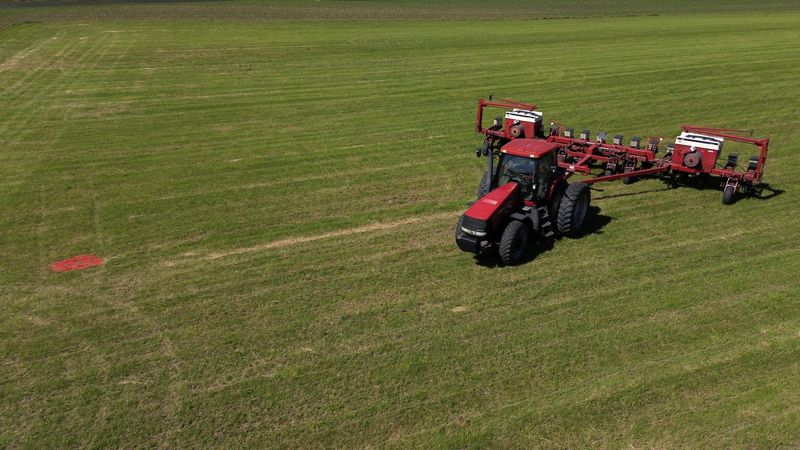By Karl Plume
CHICAGO (Reuters) - Mark Tuttle planted more soy and less corn on his northern Illinois farm this spring as prices for both crops hover near three-year lows and soybeans' lower production costs offered him the best chance of turning a profit in the country's top soy producing state.
He even planted soybeans in one of his fields for a second straight year, breaking the traditional soy-corn-soy rotation for field management. He and many other farmers are hoping to just minimize losses.
Planting more soy at a time of sputtering demand from importers and domestic processors will only serve to drive prices lower, further swell historically large global supplies and erode U.S. farm incomes already poised for the steepest annual drop ever in dollar terms.
But Midwest farmers' other main options - seeding more corn or leaving fields fallow - could have resulted in even wider losses.
"There's a better chance of making money with soybeans than there is for corn right now," Tuttle said. "But if we have another bigger crop, prices are going to go lower and that's not going to bode well for the farmer."
In March, the U.S. Department of Agriculture forecast farmers would plant 86.5 million acres of soybeans nationwide this spring, the fifth most ever. Some analysts expect soybean acres to increase by another million acres or more as heavy rains close the window on corn planting.
In nearby Princeton, Illinois, Evan Hultine also increased soy plantings and scaled back corn. High production costs due in part to a jump in interest rates looked likely to erode most or all of his corn returns, while soybeans remained marginally profitable, he said.
The farm's profits will likely be the thinnest in at least five years, Hultine said.
In an annual early season crop budget estimate, University of Illinois agricultural economists projected negative average farmer returns in the state for both crops, though losses would be smaller for soybeans.
UNPROFITABLE CROPS
In northern Illinois, farmers could lose $140 per acre on average for corn and $30 an acre for soybeans with autumn delivery prices of $4.50 and $11.50 a bushel, respectively, the analysis showed. Actual returns vary significantly from farm to farm, however, depending on factors like crop yields, the timing of grain sales and whether farmers own or rent their land.
Fertilizer costs are down from highs last year, but crop prices are also down, while land costs remain elevated and borrowing rates for operating loans and equipment have jumped, likely forcing farmers to cut expenses, the economists said.
When looking to cut costs, farmers often favor planting soybeans rather than corn because they require less fertilizer and pesticides and seed costs tend to be lower.
High interest rates have been a particularly painful expense recently.
"If you're borrowing $700 an acre to put a corn crop in at 7% to 8%, you're talking about some real dollars there just on the price of money. You can put a bean crop in a lot cheaper. Your interest cost per acre might be half," Tuttle said.
MORE SOY, LESS CORN
An early-spring forecast from the USDA projected soy plantings would expand by 3.5% this year while corn plantings were expected to shrink 4.9%.
The expansion is expected to swell the U.S. soy stockpile next season by more than 30% to the highest in five years and the sixth highest level on record as demand from the domestic and export markets is not keeping pace with rising production, according to the USDA.
Now, rain-saturated fields in some areas could clip corn acres and even further expand seedings of soybeans, which, unlike corn, can be planted well into June without significant risk to yields.
Cash prices offered for the next corn and soybean harvest have improved from earlier this spring in Spencer, Iowa, where Brent Swart has been struggling to plant the last of his corn acres due to overly wet weather. But neither crop pencils a profit at current prices.
Nearly a foot of rain over the past month, seven inches more than normal, has left his fields too soggy for field work. Swart estimates his remaining corn fields may not be in shape to plant until after his planting deadline date of June 1, when crop insurance benefits begin to drop with each day.
Swart's best option in some of his fields may be to file an insurance claim saying he was prevented from planting due to waterlogged soils. Soybean prices remain some 40 cents a bushel under his estimated cost of production, he said.
"If you switch to soybeans, you're potentially looking at a loss. If you prevent plant, you're looking at more of a breakeven scenario," Swart said.
Only farmers with severe weather issues will be able to file for insurance, however.

Weather delays and a favorable price versus corn could boost soy plantings by 500,000 to 1 million acres above the USDA's latest forecast for 86.5 million, said Tanner Ehmke, lead economist for grains and oilseeds at CoBank.
"The signal from the marketplace to the farmer right now is that, if you have a doubt about your acreage, send those acres to soybeans," he said.